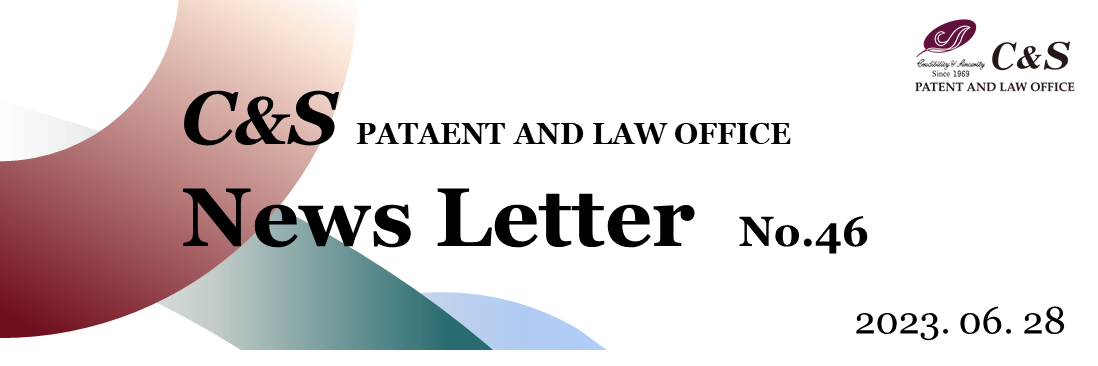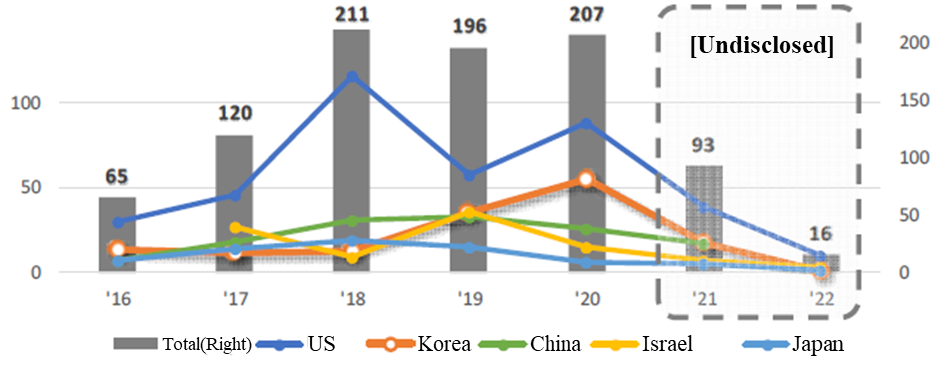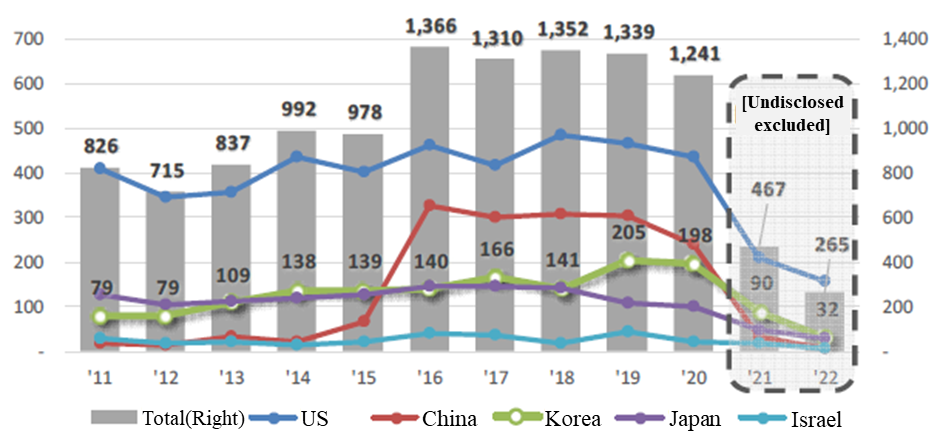C&S Newsletters
C&S Newsletter No.46
- Date2023/06/28 18:16
- Hit 209

- New Supreme Court Case Relating to Patent Infringement under Doctrine of Equivalents
- Revisions of Design Protection Act and Commentary Thereon
- Korea, 2nd in Patent Applications for Autonomous Driving Vehicle Sensor Convergence Technology
- Korea, 2nd in Growth Rate in Stem Cell Technology Patent Application
- C&S News
New Supreme Court Case Relating to Patent Infringement under Doctrine of Equivalents _Woo-Taek HWANG, Patent Attorney
[2022Heo10210 Decision of confirmation of scope of rights (special) by Supreme Court, February 20, 2023]
1. Overview
Recently, in a claim scope confirmation case, the Supreme Court (2022Heo10210) determined in detail as to whether a person skilled in the art could easily conceive, from a known technology, the change of the patented invention to the invention subject to confirmation, and whether amendments and intentional exclusions have been made at the examination stage in the Korean Intellectual Property Office. This decision is expected to have many implications in future claim scope confirmation cases or in infringement litigations.
2. Main arguments between both parties in claim scope confirmation case or infringement litigation
Generally, in a claim scope confirmation case or an infringement litigation, since the invention subject to confirmation is not literally identical to the patented invention, both parties tend to argue whether the invention subject to confirmation is an equivalent to the patented invention.
In this case, whether the invention subject to confirmation is an equivalent to the patented invention may be determined on the basis of whether the principle of solving the problem is the same, whether the purpose and effect are substantially the same, and whether such changes could be readily conceived of by a person skilled in the art from the prior art, whether it is intentionally excluded, and whether it is a known technology.
In particular, the two parties may sharply argue over whether the change of a patented invention to the invention subject to confirmation could be easily conceived of from known technologies and whether amendments and intentional exclusions were made at the examination stage in the Korean Intellectual Property Office.
3. Supreme Court Decision (2022 Heo 10210)
A. Easiness of change of elements
The Supreme Court reviewed whether the elements of the patented invention were well known at the time of making a decision for the trial, whether the manufacturing or design method of the changed elements was known, and whether the combination or substitution of the changed elements could have been easily made in a technical sense, and decided that, since it is deemed that a person skilled in the art would have no difficulty in changing dapagliflozin in the patented invention to dapagliflozin formate in the invention subject to confirmation, the change of the elements could be easily conceived of by a person skilled in the art from reference to the prior art.
B. Intentional exclusion
The Supreme Court referred to the previous Supreme Court decision that it is not concluded to intentionally exclude from the scope of the claim all elements present between before and after an amendment simply because the claim has been amended to reduce the scope of the claim during the application process, and that it could be recognized for the applicant to intentionally exclude certain elements from the scope of the claim by considering the various circumstances revealed in the application process, including an amendment for excluding the elements disclosed in the prior art with an intention of avoiding the prior art presented in the notice of rejection. The Supreme Court decided that even if the applicant made an amendment to delete the “prodrug ester” recited at the end of claim 1 of the invention in the application process patented, it may be difficult to regard that dapagliflozin formate of the invention subject to confirmation was intentionally excluded from the scope of claim 1 of the patented invention.
4. Conclusion
O Regarding whether a change of a patented invention to an invention subject to confirmation could be easily conceived of from a known technology in a claim scope confirmation case or an infringement litigation, both parties generally argue on the basis of the general inventive step criteria, but the Supreme Court made a decision by considering various technical viewpoints in the relevant technical field.
O The above decision by the Supreme Court clearly set out the criteria indicating that, in a claim scope confirmation case or an infringement litigation, the criteria for intentional exclusion of a patented invention could be recognized when it could be deemed that the applicant has an intention to exclude a certain element from the scope of the claim.
O Therefore, it is believed that the above decision by the Supreme Court could be considered by patent attorneys or companies in responding to disputes over the equivalents of claim elements in a claim scope confirmation cases or an infringement litigation.
Revisions of Design Protection Act and Commentary Thereon _Jung-Won LEE, Attorney / Patent Attorney
As the revision of the Design Protection Act was recently passed by Congress, significant changes and improvements are expected in practice when the revision is enforced.
1. Background of revision
A company develops and sells follow-up products by partially improving or modifying the design of a product after the product is launched. However, as the period for filing a design registration application for a related design is limited to one year from the date of filing a design registration application of the basic design, there has been a limitation in protection of subsequent designs through design registration.
In addition, since the methods and procedures for claiming priority in design applications are limited as compared to other major countries, there are difficulties in protecting the rights of design right holders. Furthermore, there are limited cases in which exceptions to loss of novelty can be claimed for design applications. Accordingly, in many cases, the existing Design Protection Act acted against the rights holder in disputes, such as claim scope confirmation cases and litigations for infringement and invalidation.
2. Main content of revision
1) Expansion of related design application period
In the revision, the application period for design registration of related designs has been extended from within 1 year to within 3 years of the date of filing an application for design registration of basic designs, and the requirements for registration of related designs have been clearly stipulated, which opens a way for companies to secure the scope of rights and to continuously prevent imitation or infringement through related design applications even when companies release follow-up products with partially improved designs in consideration of market reactions after a product is launched.
2) Expansion of exception to loss of novelty
In addition, in relation to the requirements for design registration, procedural provisions stipulating the exception to loss of novelty and the timing of filing documents were deleted. Furthermore, related provisions have been revised, such that successors who share the right to receive design registration, in addition to co-creators, can jointly file a design registration application.
3) Relaxation of priority claim requirements
In relation to the application for design registration under the treaty, if a person who desires to claim priority is unable to claim priority within the period due to justifiable reasons, the period will be extended by 2 months. Therefore, if the person claiming priority is unable to file documents within the period due to a justifiable reason, the document filing period will be extended by two months. Furthermore, a person who has claimed priority can amend or add to the priority claim within three months of the date of filing an application for design registration.
Korea, 2nd in Patent Applications for Autonomous Driving Vehicle Sensor Convergence Technology
Korea ranked second in patent applications for sensor convergence technology required for fully autonomous driving. The Korean Intellectual Property Office (KIPO) analyzed patents filed in five advanced countries in the field of patents (Korea, the United States, China, the European Union, and Japan), and said that the patent applications for autonomous driving vehicle cameras and sensor convergence technology increased significantly by 33.6% per year on average over the past five years.
In order to realize fully autonomous driving, sensors for accurately recognizing a surrounding environment are essential. Lidar can provide accurate distance information in a 3D space, but cannot provide accurate color and shape as a camera. “Camera-sensor convergence technology” is a technology to enhance reliability of autonomous driving by converging camera and lidar information. Each sensor can be supplemented, such that the technology can be used in fully autonomous driving vehicles of level 4 or higher.
As for the applicant nationalities, the United States had the highest share of 42.3% (338 cases), followed by Korea with 16.1% (129 cases). China followed with 14.4% (115 cases), Israel with 10.9% (87 cases), and Japan with 7.6% (61 cases). The average annual increase rate by applicant’s nationality was the highest in Korea at 40.8%. The KIPO announced that it plans to support technological development by providing information on patent trends in the future, as competition for patent applications across autonomous driving technologies is expected to be fierce.
< Patent Application Trends by Applicant Nationality (2016 to 2020) >

Source: Korean Intellectual Property Office Press release (May 7, 2023)
Korea, 2nd in Growth Rate in Stem Cell Technology Patent Application
While continued efforts have been made by countries to develop stem cell technology, the average annual growth rate of Korea in the field ranked second, indicating steady growth. Stem cells refer to undifferentiated cells having high proliferative and self-renewal capabilities and can be differentiated into all tissues and organs of the human body.
The Korean Intellectual Property Office (KIPO) announced that, as a result of analyzing patent applications filed in IP5, the patent offices of major countries, the amount of applications filed in the field of stem cells has increased by an average of 4.6% per year over the past 10 years, and the amount of patent applications in 2020 increased by about 50%, as compared to 2011. As the average annual growth rate during the same period, China was the highest at 32.6%, followed by Korea with 10.7%. The US showed a slowdown at 0.7%, and Japan showed a rather declining trend at -2.3%.
According to the statistics of applicant nationality, over the past 10 years, the United States (38.5%) filed the most applications, followed by China (15.0%), Korea (12.7%), and Japan (11.4%).
The KIPO said that the development potential of the stem cell technology with unlimited potential is limitless, and that the KIPO will conduct high-quality patent examinations and provide information to help Korean companies and research institutes secure patent competitiveness and to preoccupy the market in the stem cell-related field where competition has been intensified.
< Patent Application Trends by Applicant Nationality (2011 to 2020) >

Source: Korean Intellectual Property Office Press release (June 4, 2023)
C&S News
- Attended the 2023 International Trademark Association (INTA) Annual Conference

Representative Patent Attorney Seung-Yun Yeom, Representative Patent Attorney Eui-Hoon Lee, Partner Patent Attorney Sung-Dong Lee, and Partner Patent Attorney Tae-Hwi Kim of C&S Patent and Law Office attended the annual conference of the International Trademark Association (INTA) held in Singapore from May 16 (Tue) to 20 (Sat). The INTA annual conference is the most widely known global IP service event, and is a large-scale international conference where patent and trademark attorneys and intellectual property experts from around the world, as well as IP-related companies and institutional officials, gather once a year. Through this event, C&S Patent and Law Office communicated with intellectual property experts from various countries on the latest trends and changes in the legal system, and established close cooperative relationships with overseas representatives. We will continue to participate in various IP-related events and provide the best intellectual property services through active exchanges.
- New Patent Attorneys
C&S Patent and Law Office has recently hired a patent attorney in the field of mechanical engineering, material science and metallurgical engineering to further strengthen our business capabilities. We will continue to do our best to provide professional services by recruiting talented employees.
|
Name |
Division |
Education and Career |
|
Beom-Ju LEE |
Mechanical |
Admitted to the Korean Patent Bar, 53rd Examination Inha University, Department of Mechanical Engineering Patent Attorney, Haeum Patent and Law Office Patent Attorney, BAE, KIM & LEE Patent and Law Office |
|
Young-Kyung SHIM |
Materials and Metals |
Admitted to the Korean Patent Bar, 57th Examination Yonsei University, Department of Chemical Patent Attorney, Haeum Patent and Law Office |
|
Woo-Seok RHO |
Materials and Metals |
Admitted to the Korean Patent Bar, 58th Examination Kwangwoon University, Department of Chemical Engineering Patent Attorney, KIP Intellectual Property |
-
 FILE 1
46thNewsletterEN.pdf
(byte : 440.7K / DOWNLOAD : 59)
FILE 1
46thNewsletterEN.pdf
(byte : 440.7K / DOWNLOAD : 59)

